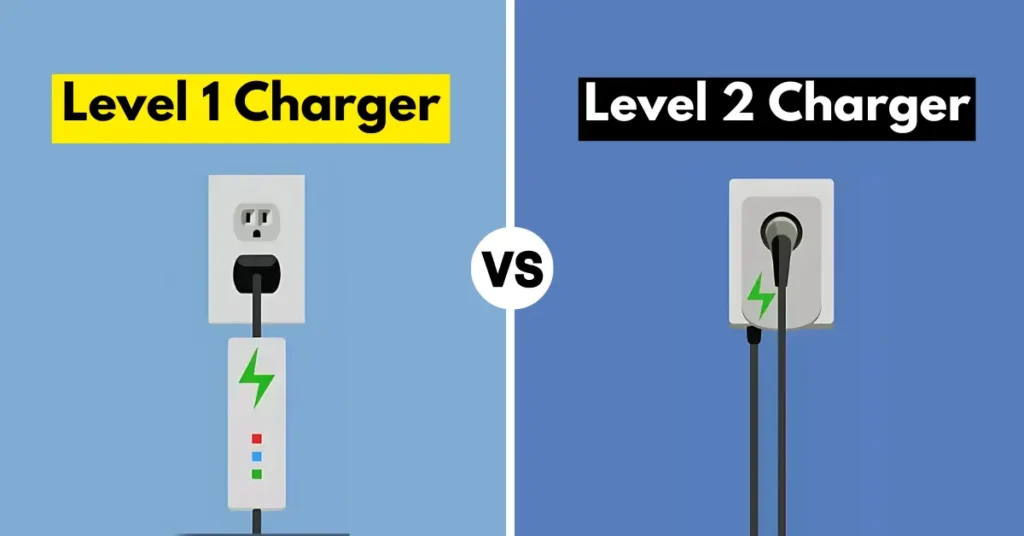
Electric vehicles (EVs) are on the rise in India and owners need to choose the right charging option. In Indian homes, there are two primary AC charging levels – Level 1 and Level 2 – that dominate home charging scenarios.
So in this article, we have compared Level 1 and Level 2 charging, focusing on their speed, efficiency, and cost.
Level 1 charging utilizes a standard household outlet in India, operating at 230 volts with a maximum current of 15 amps.
This delivers up to 3.3 kW of power, depending on the vehicle’s onboard charger and the supplied Electric Vehicle Supply Equipment (EVSE), such as the portable charger included with most EVs.
For instance, the Tata Nexon EV comes with a 15A portable charger rated at approximately 3.3 kW.
Charging speed for Level 1 depends on the vehicle’s energy efficiency, typically measured in kWh per 100 km. Assuming an average efficiency of 10 kWh/100 km (common for Indian EVs like the Tata Nexon EV or MG ZS EV), Level 1 charging adds about 33 km of range per hour (3.3 kW ÷ 0.1 kWh/km = 33 km).
For a 40 kWh battery, such as in the Tata Nexon EV Max, a full charge from 0% takes approximately 12 hours (40 kWh ÷ 3.3 kW ≈ 12 hours), though real-world times may vary due to temperature and battery conditions.
Charging efficiency—how much of the grid’s electrical energy reaches the battery—ranges from 85% to 95% for Level 1, influenced by the onboard charger and battery management system.
Losses occur due to heat and conversion inefficiencies, but these are minimal at this power level (International Energy Agency, 2022).
Level 1 charging requires no additional infrastructure beyond an existing 15A socket near your parking area, making installation costs negligible. Electricity costs depend on local tariffs—around ₹6-8 per kWh in many Indian cities—translating to ₹20-26 per hour of charging at 3.3 kW.
Level 2 charging employs a dedicated charging station, typically delivering 7.4 kW or more, though this depends on the station’s capacity and the vehicle’s onboard charger.
In India, Level 2 aligns with standards like Bharat AC001, which supports higher power outputs from a 230V single-phase supply (Bureau of Indian Standards, 2021).
Vehicles like the Tata Nexon EV Max (with a 7.2 kW onboard charger) or MG ZS EV (7.4 kW) can fully utilize Level 2 capabilities.
At 7.4 kW, Level 2 charging significantly outpaces Level 1. With the same 10 kWh/100 km efficiency, it adds approximately 74 km of range per hour (7.4 kW ÷ 0.1 kWh/km = 74 km).
For a 40 kWh battery, a full charge takes about 5.5 hours (40 kWh ÷ 7.4 kW ≈ 5.4 hours), roughly half the time of Level 1.
However, the onboard charger’s capacity is a limiting factor—vehicles with a 3.3 kW charger (e.g., some Tata Nexon EV variants) won’t exceed 3.3 kW, even on a Level 2 station.
Efficiency for Level 2 charging mirrors Level 1, staying within 85-95%. While higher power could theoretically reduce relative losses, the difference is negligible for home use (International Energy Agency, 2022).
The upfront cost for Level 2 is higher due to the charging station (₹50,000-₹1,50,000) and installation (₹10,000-₹20,000 for electrical work).
Electricity costs remain identical per kWh, but faster charging may align better with off-peak tariffs (e.g., ₹4-6/kWh at night), potentially lowering operational costs over time.
| Aspect | Level 1 (3.3 kW) | Level 2 (7.4 kW) |
|---|---|---|
| Speed | ~33 km/hour | ~74 km/hour |
| Time (40 kWh) | ~12 hours | ~5.5 hours |
| Efficiency | 85-95% | 85-95% |
| Setup Cost | Minimal (₹0) | ₹60,000-₹1,70,000 |
| Running Cost | ₹20-26/hour | ₹44-59/hour (same kWh rate) |
For Indian EV owners, the choice hinges on usage and budget:
Consider your EV model too. A Tata Nexon EV with a 3.3 kW charger sees no speed benefit from Level 2, while the Max variant (7.2 kW) does (Tata Motors, 2023).
Level 1 and Level 2 charging cater to different needs in India’s growing EV landscape. Level 1 offers simplicity and low cost, adding 30-35 km/hour, while Level 2 delivers speed (70-75 km/hour) at a higher price.
Efficiency remains consistent across both, leaving the decision to your driving habits and budget.
With initiatives like FAME-II boosting charging infrastructure (NITI Aayog), Indian users can confidently choose based on their lifestyle.
Note: Charging speeds and costs are approximate and may vary based on vehicle specifics, grid conditions, and local tariffs. Always use certified equipment for safety.
This post was last modified on March 4, 2025 11:02 am
In a major stride toward sustainable mobility, the Himachal Pradesh Police have incorporated six custom-modified Tata Curvv electric vehicles into…
In India, the automotive and transport industry is undergoing significant changes. This transformation isn't just about improving roads and infrastructure;…
Montra Electric, the clean mobility brand from the prestigious Murugappa Group, has launched the All-New Super Auto, a next-generation electric…
Union Minister Nitin Gadkari (Minister of Road Transport and Highways of India) has once again made a bold statement that’s got…
India’s electric four-wheeler (E4W) market slowed in September 2025, following a record-breaking August, with 15,038 units sold, representing an 18%…
India’s EV market hit 1,04,056 electric two-wheeler sales in September 2025. TVS, Bajaj, and Ather led the chart, while Ola…
This website uses cookies.